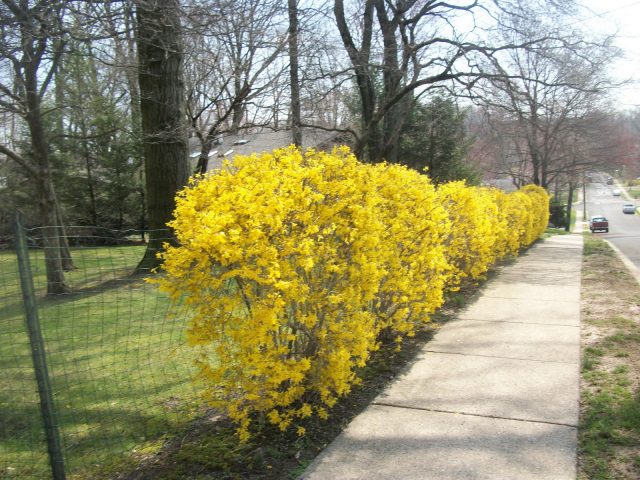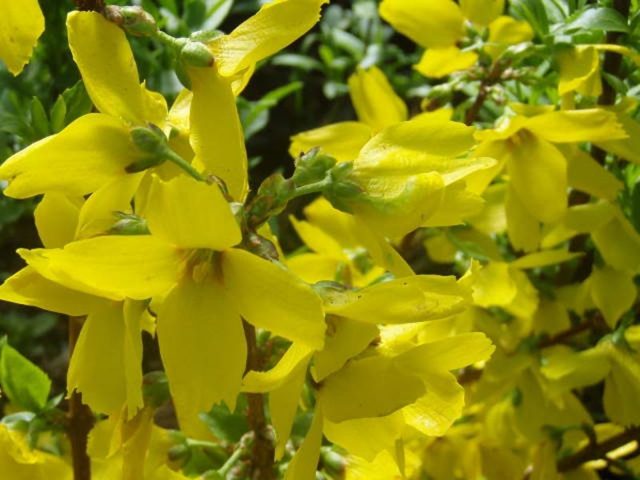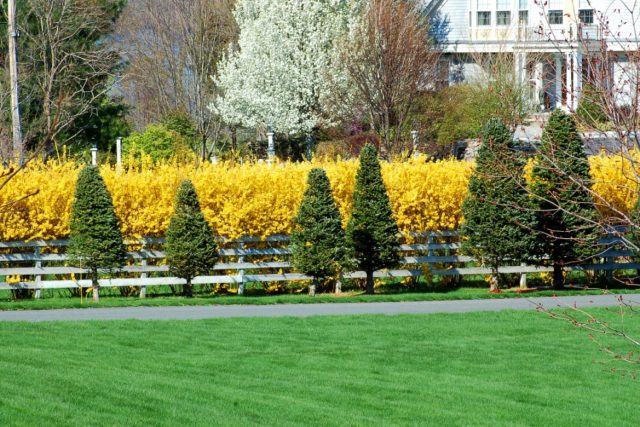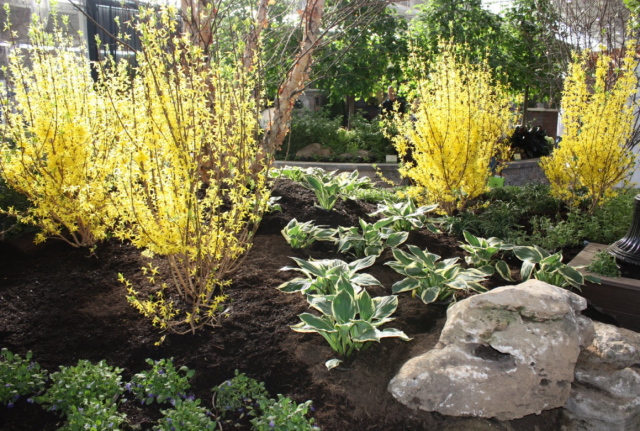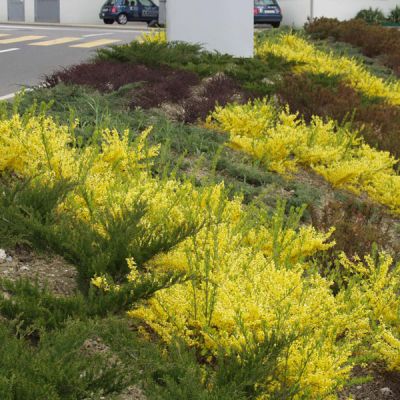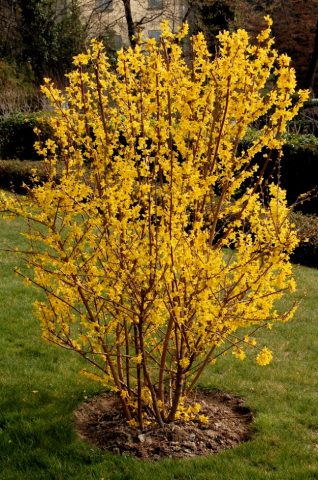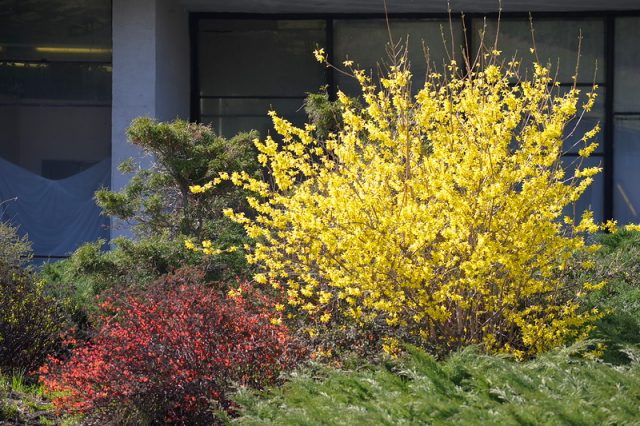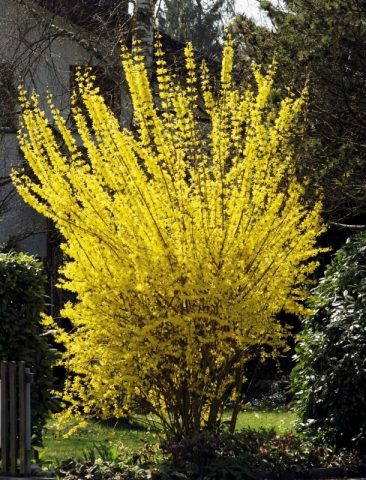Content
Forsythia average adorns gardens and squares of European cities. Its rapid flowering indicates the arrival of spring. The shrub blooms earlier than other plants. Forsythia has been in the culture for a long time. From China, the first specimens were brought to Europe by the Scotsman Forsyth, a botanist and chief gardener of Kensington Palace.
The winter hardiness of the shrub makes it possible to grow it in the conditions of the Russian winter. This decorative culture is very popular in the Moscow region.
Medium forsythia description
Medium forsythia (intermediate) is a form obtained by the method of hybridization. In the work, German breeders used the genetic material of 2 types of forsythia:
- drooping;
- dark green.
The form has been adapted in regions with a temperate climate. It is distinguished from other varieties of forsythia by frost and drought resistance. The intermediate forsythia (medium) variety appeared at the end of the 19th century. Now gardeners are offered many varieties of ornamental shrubs of this species.
Bell-shaped flowers of forsythia average are clearly visible in the photo. They have 4 brightly colored petals. The color of low-flowered inflorescences is different, a delicate lemon-yellow color - in some varieties, dark orange - in others. In most varieties of forsythia, medium flowering occurs on annual shoots.
The height of deciduous shrubs depends on the variety (2-3 m). The shape of the crown is spreading. It is formed by shoots of 2 types:
- upright;
- arcuate (drooping).
The branches are covered with light golden-yellow bark, with young shoots with a greenish tint. The shrub becomes foliage immediately after flowering, which occurs in the spring months (April, May). It lasts about 20 days.
In summer, large (5-12 cm) leaves are painted in a juicy green color, in autumn the spreading crown of shrubs pleases the eye with a bright crimson, yellow, purple color. The shape of the leaves is simple, lanceolate-ovate, the edge is serrate-toothed.
Forsythia average in landscape design
The shrub is planted in a prominent place in the garden. When properly planted, the ornamental plant becomes the highlight of the garden. In spring, blooming forsythia is very effective against the background of conifers. In autumn, shrubs do not lose their decorative effect, they attract the eye with crimson, yellow or purple foliage.
In country houses, single forsythia bushes are planted next to the porch or garden gate. In group plantings, it is combined with conifers, perennials, roses, lilacs.
Medium forsythia bushes tolerate pruning well, so they are used to create hedges.
Beautiful flowering shrub planted in city parks and squares. It looks good on the banks of water bodies.
Medium forsythia varieties
Because of the abundant flowering, forsythia is called "golden lilac" or "golden rain". Several types of ornamental shrubs are widespread in Russia:
- ovoid;
- hanging;
- European;
- average.
The varieties of the latter variety are more adapted to cold climates, the most famous are:
- Minigold - Small gold;
- Beatrix Farrand;
- Goldrausch.
Especially popular among gardeners is the forsythia medium variety Maree d'or courtasol. This is a dwarf shrub with creeping shoots, with its help they decorate gentle slopes, form picturesque hedges.
Forsythia medium Minigold
This is the smallest medium forsythia variety. The height of adult Minigold bushes does not exceed 1-1.5 m. Most often, the length of the shoots is only 0.6-0.8 m. The crown is compact, dense, up to 1.5 m in diameter.
Plant of medium vigor. During the season, the growth of branches is no more than 10 cm. Branches are brittle, erect. The leaves are dark green with light veins, simple. The form is ovoid or ovate-lanceolate. In autumn, they change color, become yellowish-green with red-burgundy blotches.
Forsythia Minigold is a winter-hardy plant. The flowering period is April-May. Flowers are medium-sized, numerous, appear before bud break. Flowering lasts from 20 to 25 days. The shrub can grow in any garden soil. Does not like drying out of the soil. Bushes require pruning for abundant flowering.
Forsythia middle Beatrix Farrand
Deciduous shrub with a height of 3 to 4 m. The annual growth of shoots is 30-40 cm. The diameter of the crown of an adult plant is about 3 m. The density of the crown is average. During the growing season, the branches are covered with oval-pointed, finely toothed leaves. Summer color of foliage is light green, autumn color is bronze or yellow-green.
Leaves appear after flowering. It falls in April, May, in warm regions - at the end of March. Bushes are very decorative in spring. Shoots are covered with large, bright, canary yellow flowers. Orange stripes are visible at the base of the petals.
Shrub likes:
- moist, drained soil;
- good lighting;
- warmth, no drafts.
In winter, it can freeze without shelter. Before the onset of frost, the branches are bent to the ground. For protection from low temperatures, they are covered with dry leaves and spruce branches. Forsythia tolerates a haircut well. For regular, abundant flowering, all faded shoots are annually shortened by ½ the length.
Forsythia medium Goldrouch
Spectacular forsythia bushes of medium Goldrash grow up to 2.5 m in height. Erect, spreading branches form an obovate crown with a diameter of up to 2 m. Separate drooping shoots.
The flowers are bright, yellow, 2-3 cm in diameter, collected in large inflorescences up to 6 cm in size. Abundant flowering occurs in the spring months (April, May). It lasts about 2 weeks. At its end, the branches are covered with dark green leaves of a simple oval-lanceolate shape. The length of the sheet plate is 8 cm.
The shrub grows well in urban environments. His winter hardiness is average. In especially harsh winters, flower buds and shoots located above the snow level freeze slightly. So that every spring you can admire the wonderful flowering, forsythia average Goldrash is recommended to be planted in places protected from the cold north wind.
This variety is unpretentious. An ornamental shrub can grow on loose, permeable loams, tolerates shade, partial shade, is responsive to organic and mineral fertilizing, and tolerates pruning well.
Planting and caring for yellow forsythia
Propagate forsythia yellow cuttings, layering, seeds. 1-2 year old seedling in a container, can be bought at a gardening store. Plants with a closed root system can be planted in the garden at any time (spring, summer, autumn).
When planting, the dimensions of the future bush are taken into account: height, crown diameter. The site should be illuminated by the sun for 6 hours, forsythia tolerates shadow, but the bush loses its decorative effect with a lack of light.
The composition of the soil does not play a big role, but if the pH is <5.5, it is worth adding ash to it when digging. Saplings are planted in pits measuring 0.5 x 0.5 x 0.6 m. After planting, the root should be at a depth of 30-40 cm. A drainage 10 cm thick is poured at the bottom (crushed stone, brick battle).
For backfill, prepare a mixture, take:
- sand (1 part);
- leafy ground (2 parts);
- peat (1 part);
- ash (200 g).
When planting several shrubs, holes are dug at a distance of 1.5-2 m. The seedlings are watered. When planting in autumn, they are prepared for winter:
- mulch the trunk circle with bark, peat, leaves;
- shoots are bent to the ground, pinned;
- at subzero temperatures, cover with lutrasil.
Care comes down to watering, feeding, pruning. Water only when the topsoil (5 cm) is dry. Top dressing is carried out with mineral fertilizers in the spring before flowering and Kemira Universal after the shrub has finished blooming.
Forsythia responds well to organic matter (humus, compost), it is used as mulch. The trunk circle is covered in spring or autumn. The first 2 years after planting, only sanitary pruning is carried out. Damaged shoots are cut out.
Starting from the 3rd year, they work with the crown in the summer:
- the faded shoots are shortened by ½;
- old branches are cut at a height of 5-6 cm from the ground, then young growth will go from them.
Rejuvenating pruning is done about once every 4 years. It is aimed at enhancing the growth of young shoots and preserving decorativeness. The branches of old bushes are shortened by ⅔ of the length. Depending on the style of the garden, the forsythia crown can be formed in the form of a cube, ball, bowl.
Plants can suffer from infection and pest infestations. For fungal diseases, wilting, the bushes are sprayed with fungicides. With bacteriosis, the diseased plant is uprooted, the earth is treated with a solution of potassium permanganate.
In summer, plant leaves can suffer from nematodes. Then the top layer of soil around the bush is removed. The soil is treated with Carbation solution. In case of aphid infestation, the leaves are sprayed with soapy water.
Wintering forsythia in the Moscow region
Forsythia average Minigold can survive wintering in the suburbs without shelter. But experienced gardeners are advised to insulate bushes, especially young ones. Before the very frosts, the plants are watered, the fallen leaves are removed, the soil is loosened and sprinkled with a layer of peat.
The shoots are carefully bent to the ground, fastened with a vine (staples). From above, the bushes are thrown with spruce branches, straw, covered with purchased covering material. In winter, snow is shoveled onto the bushes. If the snow blows away in winter, they build a shelter from wooden shields or put arcs, and stretch 2-3 layers of lutrasil.
Conclusion
Forsythia average blooms profusely in Russian gardens if the bushes are covered for the winter. Despite the winter hardiness, the threat of freezing of flower buds exists. It is worth spending a little time preparing for winter so that in spring the shrub will decorate the garden with abundant flowering.
In the video, the garden expert tells you how to properly care for a flowering plant in the middle lane:
